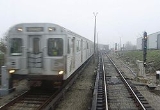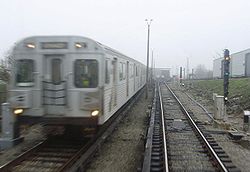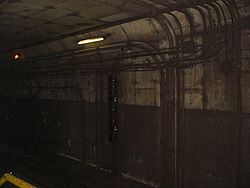
Signals on the TTC
Encyclopedia
The Toronto Subway and RT signals use a system of light-based signals to give instructions to its trains. It uses block signals commonly, as well as interlocking signals. The TTC uses the NX/UR system of signalling, which is also used in New York
on the New York City Subway
, in Chicago
on the 'L'
, and in Boston
on the subway.
. They are used to keep trains properly spaced, and are controlled by the trains themselves, based on their distance relative to other trains. The following block signals are used by the TTC.

GT (grade timing) is used in sections where a sharp turn requires a speed limit or where a downhill section would cause a train to accelerate to an unsafe speed if the driver were unwary. When entering a block which is subject to GT, one of two things controls the signal: the distance to the train ahead, or grade timing. If the current state of the signal is due to proximity to the train ahead, the white light below the signal (termed "lunar aspect" by the TTC) will not be illuminated. The lunar aspect is used only to indicate that the signal is being controlled by GT.
As well, despite the images shown above, a flashing red light may be shown without the lunar aspect. The flashing red indicates the end of a GT block whose timer has not expired, while the lunar aspect indicates the start of a GT block whose signal is currently being controlled by GT. Therefore, the signal at the end of the last block of a GT section may be flashing red to indicate that the timer has not yet run out, but that location will never have a lunar aspect since the next block is not subject to GT.
 Interlocking signals are used in interlockings, which are any areas where train movements may conflict with each other. They are controlled by either human operators or a computer, not by the trains. Interlocking signals also tell operators which way points are set. The following interlocking signals are used on the TTC.
Interlocking signals are used in interlockings, which are any areas where train movements may conflict with each other. They are controlled by either human operators or a computer, not by the trains. Interlocking signals also tell operators which way points are set. The following interlocking signals are used on the TTC.
, where by a signal's number is assigned based on the nearest chain measure.
Each line or portion of a line has an assigned letter, and that precedes the number ascertained by the Chain measure. Signals that are on a northbound portion of track use the nearest even valued chain measure, where signals on a southbound portion of track use the nearest odd valued chain measure.
New York
New York is a state in the Northeastern region of the United States. It is the nation's third most populous state. New York is bordered by New Jersey and Pennsylvania to the south, and by Connecticut, Massachusetts and Vermont to the east...
on the New York City Subway
New York City Subway
The New York City Subway is a rapid transit system owned by the City of New York and leased to the New York City Transit Authority, a subsidiary agency of the Metropolitan Transportation Authority and also known as MTA New York City Transit...
, in Chicago
Chicago
Chicago is the largest city in the US state of Illinois. With nearly 2.7 million residents, it is the most populous city in the Midwestern United States and the third most populous in the US, after New York City and Los Angeles...
on the 'L'
Chicago 'L'
The L is the rapid transit system serving the city of Chicago and some of its surrounding suburbs. It is operated by the Chicago Transit Authority...
, and in Boston
Boston
Boston is the capital of and largest city in Massachusetts, and is one of the oldest cities in the United States. The largest city in New England, Boston is regarded as the unofficial "Capital of New England" for its economic and cultural impact on the entire New England region. The city proper had...
on the subway.
Block signals
Block signals are the most commonly used signals on the Toronto subway and RTToronto subway and RT
The Toronto subway and RT is a rapid transit system in Toronto, Ontario, Canada, consisting of both underground and elevated railway lines, operated by the Toronto Transit Commission . It was Canada's first completed subway system, with the first line being built under Yonge Street, which opened in...
. They are used to keep trains properly spaced, and are controlled by the trains themselves, based on their distance relative to other trains. The following block signals are used by the TTC.

 |
Proceed |
 |
Proceed with Caution, next signal is currently red |
 |
Stop and Stay |
 |
Entering Timed Block, next signal is red only due to grade timing |
 |
Timed Block, timer has not yet run out (red light flashes when timer is about to run out), next block is timed as well as lunar aspect is indicated (in this example this signal would only clear to yellow) |
GT (grade timing) is used in sections where a sharp turn requires a speed limit or where a downhill section would cause a train to accelerate to an unsafe speed if the driver were unwary. When entering a block which is subject to GT, one of two things controls the signal: the distance to the train ahead, or grade timing. If the current state of the signal is due to proximity to the train ahead, the white light below the signal (termed "lunar aspect" by the TTC) will not be illuminated. The lunar aspect is used only to indicate that the signal is being controlled by GT.
As well, despite the images shown above, a flashing red light may be shown without the lunar aspect. The flashing red indicates the end of a GT block whose timer has not expired, while the lunar aspect indicates the start of a GT block whose signal is currently being controlled by GT. Therefore, the signal at the end of the last block of a GT section may be flashing red to indicate that the timer has not yet run out, but that location will never have a lunar aspect since the next block is not subject to GT.
Interlocking signals

 |
Proceed, Points Set to Straight |
 |
Proceed With Caution, Points Set to Straight, Next signal is currently red |
 |
Proceed With Caution, Points Set to Diverge |
 |
Stop And Stay |
 |
Call On (Train has been given permission to pass red signal) |
 |
Entering Timed Block, Points Set to Straight, next signal is red only due to grade timing |
 |
Entering Timed Block, Points Set to Diverge |
 |
Timed Block, timer has not yet run out (top red light flashes when timer is about to run out), next block is timed as well as lunar aspect is indicated (in this example this signal would only clear to yellow over green) |
Signal numbers
All signals have an alpha-numeric number that relates to their location within the subway system. The number is assigned using the Chain system of measurementChain (unit)
A chain is a unit of length; it measures 66 feet or 22 yards or 100 links . There are 10 chains in a furlong, and 80 chains in one statute mile. An acre is the area of 10 square chains...
, where by a signal's number is assigned based on the nearest chain measure.
Each line or portion of a line has an assigned letter, and that precedes the number ascertained by the Chain measure. Signals that are on a northbound portion of track use the nearest even valued chain measure, where signals on a southbound portion of track use the nearest odd valued chain measure.
| Line | Signal prefix | Even | Odd | Chain 0 mark |
|---|---|---|---|---|
| Yonge | N (northbound only) S (southbound only) |
northbound | southbound | Does not exist (continues from the University numbers) |
| University | U | northbound | southbound | South of St George station (counts up towards Museum) |
| Spadina | SP | northbound | southbound | North of St George station (counts up towards Spadina station (YUS)) |
| Bloor-Danforth | B | westbound | eastbound | West of Kipling station (counts up towards Islington) |
| Sheppard | SHP | westbound | eastbound | West of Sheppard station (counts up towards Bayview) |
Temporary signals
In work zones, staff place yellow beacons on the track bed between the rails to inform train operators that a 'slow order' is in effect; the first beacon is usually accompanied with a speed restriction sign indicating the speed limit for the affected area. A green beacon indicates the end of an work zone and allows operators to resume normal operation. In outdoor sections, yellow and green flags are also used for the same purpose. A flashing blue light on the tracks indicates that workers may be present, and subway operators are required to sound the horn to warn them.See also
- Toronto subway and RT#Signal information
- 1995 Russell Hill subway incident
- Railway signallingRailway signallingRailway signalling is a system used to control railway traffic safely, essentially to prevent trains from colliding. Being guided by fixed rails, trains are uniquely susceptible to collision; furthermore, trains cannot stop quickly, and frequently operate at speeds that do not enable them to stop...

